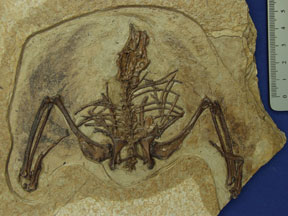|
News Notes
Paleontology
Ancient bird fossil makes a splash
 Recent
expeditions in a remote area of China have unearthed unusually well-preserved
fossils of an ancient bird that lived between 105 million and 115 million
years ago. The fossils of the surprisingly modern-looking bird suggest
that today’s birds may have originated from an aquatic ancestor.
Recent
expeditions in a remote area of China have unearthed unusually well-preserved
fossils of an ancient bird that lived between 105 million and 115 million
years ago. The fossils of the surprisingly modern-looking bird suggest
that today’s birds may have originated from an aquatic ancestor.
A nearly complete fossil skeleton of Gansus yumenensis is helping paleontologists learn more about bird evolution. Dark brown spots on the fossil represent preserved feathers associated with both wings. Photograph is by Hai-lu You/CAGS.
In the June 16 issue of Science, a team of researchers, led by Hai-lu You of the Chinese Academy of Geological Sciences, described fossil remains of five Gansus yumenensis individuals that form almost a complete skeleton, minus the skull and the first few neck vertebrae. The ancient bird, as it turns out, looks quite modern.
“With a few exceptions, you could put any of its bones next to those of a modern bird and you would be hard pressed to see major differences,” says Jerald Harris of Dixie State College in Utah, who was part of the expedition team. The ancient bird thus may help fill in gaps in the branch of the evolutionary tree that gave rise to today’s birds. Specifically, scientists are looking to the fossil for present-day evidence of whether modern birds originated in aquatic or terrestrial habitats.
The G. yumenensis fossils indicate webbed feet and a large crest on the lower leg bone that would have provided a strong anchor for leg muscles — suggesting the bird was aquatic and had the ability to dive and swim underwater like loons or grebes. According to You’s research team, these features support the idea that modern birds actually originated in water habitats.
Jennifer Yauck
For more about the bird fossil find, read the original story posted online June 15.

 Subscribe
Subscribe

